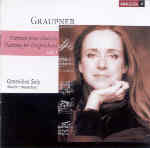Playing a gorgeously smooth-toned Hubbard & Broekman harpsichord based on the 1730s design of German instrument maker H.A. Hass, Geneviève Soly has unearthed a major Baroque treasure trove. Christoph Graupner (1683-1760), as his dates indicate, was an exact contemporary of Bach, Handel, Vivaldi, Couperin, Rameau, Telemann–in short, of all of the High Baroque masters–and on the evidence here he surely belongs in their company. He spent most of his working life in the court at Darmstadt and famously turned down the job of Cantor in Leipzig, a decision that cleared the way for the hiring of J.S. Bach.
Graupner left more than 2,000 works along with instructions that all of his music should be destroyed on his death (no wisecracks now!), which fortunately for us didn’t happen. A superb calligrapher, his elegantly written manuscripts (along with copies of various pieces in other hands) have been preserved in Darmstadt and elsewhere, among them some 40 keyboard partitas–and if this Volume 1 of a projected series is at all typical of what we can expect, then music lovers (not to mention Analekta and Ms. Soly) have years of fun ahead of them.
All three of the partitas represented here, each comprised of seven to nine movements, begin with an improvisatory Praeludium and include at least one Allemande, Courante, Sarabande, and Menuet. Otherwise, variety reigns, and even within the standard dances there’s a world of contrast to savor. Take the Allemandes: that of the A minor Partita proceeds calmly, with elegant filigree (so beautifully managed by Soly that you can practically see her caress the keyboard), while the corresponding number in the C major Partita opens with what very well could be a sturdy folk tune. On the other hand, the Allemande in the A major Partita, with its sequences and repetitions, could have come from the pen of a sort of hearty, German Scarlatti (also true of the ensuing Gigue). The same work’s wildly asymmetrical Menuet and its obstinately repetitious Bourrée also reveal Graupner to have been a musician with a keen sense of humor–not necessarily a noteworthy feature in much of the music of this period.
The other numbers also bring their fair share of delights and surprises. Airs I et II in the A minor Partita aren’t the expected lyrical effusions, but rather are lively tunes played at sprightly tempos. The C major Partita offers two contrasting Courantes, the first a fiery exercise in the Italian manner full of rapid runs and flourishes that Soly projects with infectious enthusiasm, while the second represents the smoothly flowing French style.
Clearly the most ambitious of the three works, the A major Partita finds room for a characterful Air et Variations. It concludes with a nearly 10-minute-long Chaconne, brilliantly rendered by Soly with crystal clear bass lines, that explores an entire world of expression (including some very interesting chromatic harmony) over a simple descending four-note scale. Having embarked on this ambitious voyage of discovery, Soly clearly relishes the task before her and plays every single piece with proprietary pride abetted by scrupulous taste and effortless technique. Analekta also has captured her lovely instrument in ideally warm, natural sound. What a find! [2/8/2003]
































